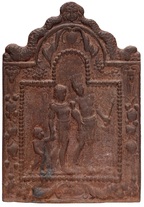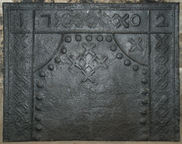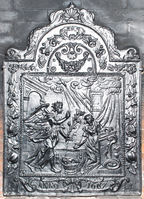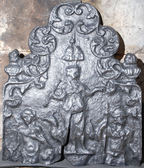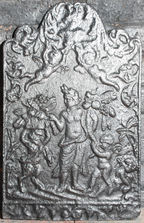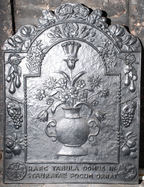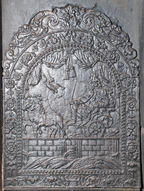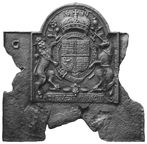-
1198
Description: Arched rectangular central panel with beaded edging, containing an image of a semi-naked adult male with feathered headdress and 'grass' skirt and holding a club in his left hand; beside hima an adult female also wearing a 'grass' skirt and with a bird perched on her left hand, while holding with her right hand a standing child; within an arched rectangular border with fillet edging, descending from draped foliage on each side, swags or what appear to be coconuts or gourds, and at the bottom a cartouche between swirled foliage; on top, the mask of a putto with dolphins descending on each side.
Notes: One of a series portraying allegories of the four known continents - Europe, Asia, Africa and America; each comprises a pair of adults and a child dressed stereotypically, in this case representative of America. The images were derived from other media, such as paintings or engravings. A copy.
Copies of this fireback are known.
- Decoration tags:
- 'Dutch' (shape)
- fillet (edging)
- whole carved pattern
- pictorial
- allegorical
- animals
Manufactured: in the mid- to late-17th century in the Siegerland area of Germany.
Current location: not known.
Citation: Elling, W. & Winkler-Borck, S., 1992, Ofen- und Kaminplatten (Vreden, Hamaland-Museum).
- Attached to series:
- 'Dutch' Continents firebacks
-
1022
Description: Rectangular, with double fillet edging (top and sides); fillets parallel to top and to each side, dividing the plate into two square corner panels and narrow rectangular panels along top and down each side; fillet arc across inside top corners; date split between top corners, divided by vertical fillets, and separated by a hollow saltire stamp repeated six times; one hollow saltire, with a central bead, between each corner arc; eight similar saltire stamps down each side panel; 27 'daisy heads' arranged regularly around outer edge of central panel, with five saltires arranged in a cross shape in the centre.
Notes: The arc shape and use of repeated 'daisy heads' suggests a common source with other firebacks of the same period; the poor definition is due to insufficient impression at the moulding stage.
Inscription: 17 02
- Decoration tags:
- rectangular (shape)
- fillet (edging)
- carved stamps
- individual numbers
Manufactured: in 1702 in the Forest of Dean area of England.
Current location: Tolsey Museum, 126 High Street, Burford, Oxfordshire, England.
(part of the Tolsey Museum, Burford museum group)
- Attached to series:
- Hollow saltire series
- Newent area group
-
21
Description: Rectangular central panel with bead edging all round, pictorial representation of the Annunciation by the Angel Gabriel to the Virgin Mary, the angel carries a lily, Mary kneels at a desk, between them is a basket, above them a dove descends from clouds amid sunbeams, to the left is an arch, in the centre a bed, and to the right a window and a canopy; above the panel is a bead-edged arch with a central scallop shell and a floral swag suspended from scrolls; arched rectangular shaped border with fillet edging, a cascade of leaves and fruit (inc. apples, grapes, pears and pomegranates) descending from a wreath, at the base two cartouches conjoined by a scallop shell and containing the inscription; on top a scallop shell between two dolphins.
Notes: A common fireback design originating in the Siegerland of north Germany and made for the Dutch market. A good clear casting. The illustration is copied from Virgil Solis, 'Biblische Figuren',1562.
Copies of this fireback are known.
Inscription: ANNO 1667
Manufactured: in 1667 in the Siegerland area of Germany.
Current location: Bateman's, Burwash, East Sussex, England.
Museum number: 761056 (part of the National Trust museum group)
Citation: Herskamp, W, 2007, Die Eiserne Bibel (Helios, Aachen).
- Attached to series:
- 'Dutch' Miscellaneous Firebacks
- New Testament firebacks
-
25
Description: Quasi-arched rectangular shape with arch decorated with floral swirls and an urn on each shoulder; three female figures: Aphrodite on the left, Hera in the centre on a plinth with two peacocks behind her, and Athena on the right; a double tassel hangs above Hera’s head.
Notes: The figures are the participants in the Judgement of Paris, the outcome of which precipitated the Trojan War.
Copies of this fireback are known.
- Decoration tags:
- rectangular with ornate arch (shape)
- fillet (edging)
- whole carved pattern
- pictorial
- mythological
- humans
Manufactured: in the early-18th century in England.
Current location: Bateman's, Burwash, East Sussex, England.
Museum number: 761070 (part of the National Trust museum group)
- Attached to series:
- Late pictorial series (all)
- Late pictorial series 4
-
26
Description: Quasi-arched rectangular shape with swirled and draped foliage across the top; fillet edging with bottom panel containing indistinct floral scrolls; figure of Plenty/Abundance holding a bunch of fruit, accompanied on her left by a cherub, and receiving a further bunch of fruit from a faun to her right; two cherubs hold foliage aloft.
Notes: The figure of Plenty is one of the representations in the Iconologia, published in the early 17th century by Cesare Ripa, and subsequently in other editions. They frequently form the subject of firebacks.
Copies of this fireback are known.
- Decoration tags:
- rectangular with round arch (shape)
- fillet (edging)
- whole carved pattern
- pictorial
- allegorical
- humans
Manufactured: in the early-18th century in England.
Current location: Bateman's, Burwash, East Sussex, England.
Museum number: 761087 (part of the National Trust museum group)
- Attached to series:
- Late pictorial series (all)
-
813
Description: Arched rectangular central panel with bead and fillet edging; two-handled vase with flowers issuing from it, a triple plume of ostrich feathers above, and in the bottom right corner the inscribed inscription, 'CofA' [Charteris of Amisfield]; arched rectangular border with fillet edging; central rose at top of arch with other flowers to each side; successive bunches of pears, grapes and apples descending down each side; inscription (Haec tabula domus instauratae focum ornat) in relief in two rows along the bottom, with circular badges of the National Heritage Memorial Fund to left, and National Trust to right; on top, rope knotted in two loops, each containing half of the date in relief, with descending leaves and flowers on each side.
Notes: This fireback was cast for Martin, Lord Charteris of Amisfield (1913-99), Trustee of the National Heritage Memorial Fund, from a pattern he designed and made, to commemorate the completion of restoration work to Canons Ashby.
Inscription: 1984 / CofA / HAEC TABULA DOMUS IN- / STAURATAE FOCUM ORNAT [this plate adorns the hearth of a restored house]
Manufactured: in 1984 in England.
Current location: Canons Ashby, Canons Ashby, Northamptonshire, England.
Museum number: 494619 (part of the National Trust museum group)
- Attached to series:
- British 'Dutch' style firebacks
- Commemorative firebacks
- Martin Charteris firebacks
-
222
Description: Arched rectangular central panel with ‘nutshell’ edging on a broad fillet; crowned figure, holding a sceptre in his right hand, sitting in a chariot drawn to the left by two horses with ostrich feather head-dresses; the whole upon a causeway with pilasters and masonry, and waves beneath; a heron flying to the left; above, swagged drapery with two tassels hanging from the centre; arched rectangular shaped border with fillet edging, symmetrical, flower bunches, descending from a ribbon loop; monogram centre bottom, between plant tendrils; on top, symmetrical scrolled plant tendrils.
Notes: The design is derived from a personification of Europe, one of a set of playing cards entitled 'Jeu de la Géographie', designed by Stefano della Bella (1677); a similarity with Queen Anne may not be coincidental; the flying heron has been copied from a print by Wenceslaus Hollar c.1658.
Copies of this fireback are known.
Inscription: SHR
- Decoration tags:
- 'Dutch' (shape)
- fillet (edging)
- whole carved pattern
- pictorial
- allegorical
- monogram
- text
- animals
- humans
- objects
Manufactured: in the late-17th to early-18th century in England.
Current location: Canons Ashby House, Canons Ashby, Northamptonshire, England.
Museum number: NT/L/CAN/M/79 (part of the National Trust museum group)
- Attached to series:
- SHR series
- British 'Dutch' style firebacks
-
224
Description: Composite; Arched rectangular shaped, armorial fireback, cavetto edging, with Stuart Royal arms, garter, supporters, crown and motto, and 1639 date above crown; this overlies a rectangular plate, with rope-effect, fillet edging; a pattern of four rosettes surrounding a fleur-de-lys, its stem terminating in a small buckle, is repeated on each side of the central armorial fireback, with the initials above; each rosette is stamped separately.
Notes: The armorial may originally have been one of the 1619 series. Formerly at Wonastow Court, Momouthshire
Inscription: 1639 / G / HONI SOIT QVI MAL Y PENSE / DIEV ET MO DROIT
Arms: English Stuart royal
- Decoration tags:
- rectangular with round arch (shape)
- fillet (edging)
- whole carved pattern
- composite
- individual letters
- armorial
- text
Manufactured: in 1639 possibly in the Forest of Dean area of England.
Current location: National History Museum, St Fagans, Glamorgan, Wales.
Museum number: 40.428 (part of the Welsh National History Museum museum group)
-
226
Description: Arched rectangular shaped central panel with bead-and-pellet edging on a wide fillet; central pedestal with a wyvern fountain ringed with water, and a swan and a duck swimming, plants rising from the waves; above, swags of drapery with two central tassels; arched rectangular shaped border with fillet edging, symmetrical floral fronds descending from a rose, top centre, with a looped 'W' in each shoulder; inscription at base, between date; on top, symmetrical scrolled plant tendrils. A single vertical plankline right of centre.
Notes: One of a group of firebacks all of the same date, some of which have the same Welsh inscription which translates as 'God is our strength'. All incorporate the looped 'W' motif which may be intended to identify the pattern maker. The design is taken from 'Livres de Fontaines' by Daniel Marot (1661-1752) (La Haye & Amsterdam 1701). The swan and the duck swimming may have been copied from etchings or paintings by Francis Barlow (c.1624-1709), whose images of birds have been used incidentally on other firebacks. Formerly at Allt-y-ferin, Nantgaredig, Carmarthenshire.
Copies of this fireback are known.
Inscription: 17 DVW Ydyw Ein Cadernid 24
- Decoration tags:
- 'Dutch' (shape)
- fillet (edging)
- whole carved pattern
- planklines
- pictorial
- architectural
- text
- animals
- plants
- objects
Manufactured: in 1724 in England.
Current location: National History Museum, St Fagans, Glamorgan, Wales.
Museum number: 62.156 (part of the Welsh National History Museum museum group)
- Attached to series:
- 1724 series
- Welsh inscription series
- British 'Dutch' style firebacks
-
233
Description: Arched rectangular central panel, bead edging, a stork, to the left, its beak in the top of a tall vase, a fox seated to the right, a tree behind; arched rectangular border, fillet edging, swags of fruit bunches (missing at the sides) suspended from ribbon, inscription below central panel; on top, symmetrical floral swirls and flowers.
Notes: The scene is drawn from 'The Fox and the Stork', one of Aesop's fables. A recasting. Formerly at Ffynnon Deilo, Pendoylan, Glamorgan.
Copies of this fireback are known.
Inscription: 16 NDW 97
- Decoration tags:
- 'Dutch' (shape)
- fillet (edging)
- whole carved pattern
- pictorial
- mythological
- text
- animals
- objects
Manufactured: in 1697 in the Siegerland area of Germany.
Current location: National History Museum, St Fagans, Glamorgan, Wales.
Museum number: 59.461 (part of the Welsh National History Museum museum group)
- Attached to series:
- 'Dutch' NDW series
